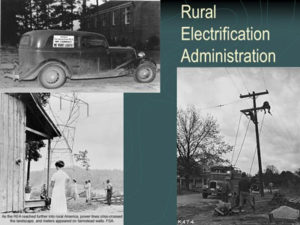
Many farm families were hesitant about electricity and its cost; but those in favor canvassed miles and miles of farmland. Volunteers urged everyone to sign up and light up the night. (Rural Electrification Administration)
Congratulations to Brandon Darrow and Farmers Electric Cooperative. They have recently received a Texas Historical Marker for the electric cooperative put together for and by citizens in rural Texas in the middle 1930s.
Electricity in an American city became available in the 1880s. Greenville actually had electrical service as early as 1891. But the vast numbers of Americans who lived in rural areas with no electric power was huge. As Brandon Darrow wrote, “there was no profit in delivering electricity to the backwoods farmer and his family.” Such was the sentiment of city dwellers through the 1920s.
Farmers had used cooperatives to run cotton gins, purchase equipment and supplies since the 1870s. While never completely successful, rural citizens and small town folks invested in cooperative shares readily.
With the onslaught of the Great Depression and the election of Franklin D. Roosevelt, the president pushed for rural electrification as a means of adding jobs and creating better living conditions for farmers. Federal aid and use of cooperatives were vital to the experiment.
In May 1935 President Roosevelt signed an Executive Order for the establishment of the Rural Electrification Administration or REA as another New Deal means of dealing with financial difficulties and rampant unemployment created by the Great Depression.
Senator George W. Norris of Nebraska and Representative Sam Rayburn of Texas sponsored the bill. Rayburn represented Northeast Texas in Congress and worked diligently for his constituents. Both men represented states that were some of the most devastated by the Dust Bowl and Depression. They understood farmers and their families drastically need help. The bill passed and was signed by Roosevelt just one year after the original executive order to create the REA was issued.
Darrow explained that the loan funding “would be available through REA and local manpower was at hand, small electric coops began popping up around the countryside, and in Northeast Texas. Tri-County Electric Cooperative, Inc. began in 1936 as did Rockwall County Electric Cooperative.” Tri-County consisted of rural residents in Hunt, Hopkins, and Rains County. The two cooperatives merged in August 1937 to become Farmers Electric Cooperative.
Immediately 1,950 meters were purchased, 500 easements were obtained, and 594 miles of line were installed between January and September 1938 for 101 new customers who had lights in their homes and barns. The following year the federal government gave a $215,000 allotment to Farmers Electric Cooperative. This allowed 860 more customers along 221 miles of power lines to see in the dark. At that point FEC began to service Hunt, Hopkins, Delta, Rains, Wood, Collin, and Rockwall Counties.
Darrow pointed out “it took a great amount of work and cooperation to explain the proposition to the people, and get them sold enough on the idea that they would sign requests for service. It took house to house canvassing; it required the contribution of time and talent. The results were not always encouraging. The idea was new to the people and many were skeptical and private power companies were carrying on a vicious campaign at the same time against the REA program.” However, folks often refer to the day they received electric service as one of the greatest days of their lives.

I know my parents were still thrilled to “turn on the lights” back in the early 40’s out by Honey creek……..rare to see an electric light in a barn for quite some times.